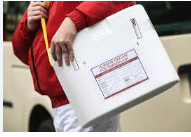According to a research released on Wednesday, the risk of mortality for kidney donors has decreased by more than half over the past ten years.
Senior author of the study and transplant surgeon at NYU Langone Health Dr. Dorry Segev stated, “It’s just becoming safer and safer for people to donate.”

Although there has always been a small chance of mortality for kidney donors generally, chances have been further enhanced by improvements in medical care and surgery as well as more cautious donor selection.
The kidneys are essential to good health because they control blood pressure and remove dangerous pollutants from the blood. The demand for kidney donors has grown as chronic illnesses like diabetes and high blood pressure, both of which can lead to renal disease, have become increasingly common.
In the United States, there are around 90,000 kidney transplant candidates, with an average waiting period of three to five years. With an estimated 27,000 kidney transplants performed each year, kidneys are the most frequently donated organ.
Physicians examined data on patients who passed away within 90 days following kidney transplant surgery from 1993 to 2022 for the latest research, which was published in JAMA. The Organ Procurement and Transplantation Network, a charity that manages the only transplant network in the US approved by the US Congress, and the Scientific Registry of Transplant Recipients provided the data.

The research encompassed 164,593 kidney donors in total. Sixty-six people passed away ninety days following donation.
Following the operation, there were 13 fatalities in total from 1993 to 2002, or 3 deaths per 10,000 individuals; from 2003 to 2012, there were 18 deaths, or 2.9 deaths per 10,000 people.
Between 2013 and 2022, the number of deaths decreased dramatically to just five, or 0.9 deaths per 10,000 people.
According to Segev, laparoscopic surgery—a minimally invasive procedure in which doctors remove the kidney using tiny incisions and specialized tools—became the norm throughout this period. Patients used to have open donor nephrectomy, which involved a considerably wider incision, a lengthier recovery period, and a higher chance of complications.
Male donors and those with a history of high blood pressure had higher mortality rates within 90 days following surgery in past decades. Within the first seven days following surgery, the majority of fatalities took place. Hemorrhage, or excessive bleeding, was the procedure’s most frequent cause of mortality.
As the healthcare community caring for these patients, we have a responsibility to ensure that the message is consistent, according to Dr. Kassem Safa, associate medical director of Massachusetts General Hospital’s kidney transplant program. “We are honest with them about the risks they are assuming, and this study merely confirms that the surgery is extremely safe and carries a very low risk—not a zero risk.”
The safety of this treatment is of utmost importance, as many kidney donors were previously well and had no health issues.
“We inform donors right away that they are not required to participate and will not receive any health benefits from it,” Safa said.
Thankfully, long-term data on organ donors has demonstrated that their kidney function often stays constant and that their chance of acquiring chronic renal disease is just marginally greater than that of non-donors, according to Safa.
Physicians believe that encouraging information like this will eventually contribute to resolving the donor shortage in the United States.
“Anything that shows that it is becoming safer and safer to be a living donor will hopefully inspire more people to come forward and donate and give the gift of life,” stated Dr. John Friedewald, medical director of Northwestern Medicine’s kidney transplant department.
In the end, this new data will assist doctors properly consent patients who are about to have the operation, according to Friedewald, who was not involved in the study.
In 2009, Tracy McKibben, the National Kidney Foundation’s chair of the board of directors, gave her mother a kidney. Her mother had stopped doing many of the things she loved since she had to visit a dialysis facility three days a week. She had previously been a highly busy person and frequent traveler.





